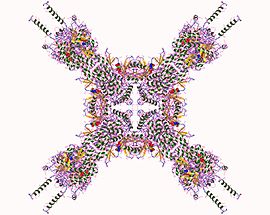1-phosphatidylinositol 4-kinase
| 1-phosphatidylinositol 4-kinase | |||||||||
|---|---|---|---|---|---|---|---|---|---|
 Phosphatidylinositol 4-kinase homo16mer, Human | |||||||||
| Identifiers | |||||||||
| EC no. | 2.7.1.67 | ||||||||
| CAS no. | 37205-54-2 | ||||||||
| Databases | |||||||||
| IntEnz | IntEnz view | ||||||||
| BRENDA | BRENDA entry | ||||||||
| ExPASy | NiceZyme view | ||||||||
| KEGG | KEGG entry | ||||||||
| MetaCyc | metabolic pathway | ||||||||
| PRIAM | profile | ||||||||
| PDB structures | RCSB PDB PDBe PDBsum | ||||||||
| Gene Ontology | AmiGO / QuickGO | ||||||||
| |||||||||
In enzymology, a 1-phosphatidylinositol 4-kinase (EC 2.7.1.67) is an enzyme that catalyzes the chemical reaction
- ATP + 1-phosphatidyl-1D-myo-inositol ADP + 1-phosphatidyl-1D-myo-inositol 4-phosphate
Thus, the two substrates of this enzyme are ATP and 1-phosphatidyl-1D-myo-inositol, whereas its two products are ADP and 1-phosphatidyl-1D-myo-inositol 4-phosphate.
This enzyme belongs to the family of transferases, specifically those transferring phosphorus-containing groups (phosphotransferases) with an alcohol group as acceptor. The systematic name of this enzyme class is ATP:1-phosphatidyl-1D-myo-inositol 4-phosphotransferase. Other names in common use include phosphatidylinositol kinase (phosphorylating), phosphatidylinositol 4-kinase, phosphatidylinositol kinase, type II phosphatidylinositol kinase, PI kinase, and PI 4-kinase. This enzyme participates in inositol phosphate metabolism and phosphatidylinositol signaling system.
Structural studies
[edit]As of late 2007, the structure has only been solved for this enzyme. Part of the enzyme was crystallized with its activating partner frequenin.[1]
References
[edit]- ^ Strahl T, Huttner IG, Lusin JD, et al. (October 2007). "Structural insights into activation of phosphatidylinositol 4-kinase (Pik1) by yeast frequenin (Frq1)". J. Biol. Chem. 282 (42): 30949–59. doi:10.1074/jbc.M705499200. PMID 17720810.
- Colodzin M, Kennedy EP (1965). "Biosynthesis of diphosphoinositide in brain". J. Biol. Chem. 240 (10): 3771–80. doi:10.1016/S0021-9258(18)97109-7. PMID 4284712.
- Kai M, White GL, Hawthorne JN (1966). "The phosphatidylinositol kinase of rat brain". Biochem. J. 101 (2): 328–37. doi:10.1042/bj1010328. PMC 1270113. PMID 4290722.
- Walker DH, Dougherty N, Pike LJ (1988). "Purification and characterization of a phosphatidylinositol kinase from A431 cells". Biochemistry. 27 (17): 6504–11. doi:10.1021/bi00417a046. PMID 2851325.
- Whitman M, Downes CP, Keeler M, Keller T, Cantley L (1988). "Type I phosphatidylinositol kinase makes a novel inositol phospholipid, phosphatidylinositol-3-phosphate". Nature. 332 (6165): 644–6. Bibcode:1988Natur.332..644W. doi:10.1038/332644a0. PMID 2833705. S2CID 4326568.
- Barylko B; Gerber, SH; Binns, DD; Grichine, N; Khvotchev, M; Südhof, TC; Albanesi, JP (2001). "A novel family of phosphatidylinositol 4-kinases conserved from yeast to humans". J. Biol. Chem. 276 (11): 7705–8. doi:10.1074/jbc.C000861200. PMID 11244087.

